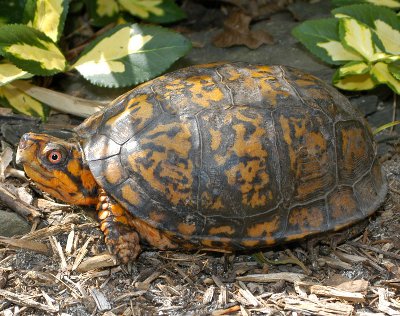Box Turtle
Category: Turtle

Facts about Box Turtles. "Scientific name for Box Turtle is Terrapene carolina carolinais". The Box Turtle is also known as the box tortoise. The box turtle belongs to the genus Terrapene. However, the box tortoise does not belong to the family of tortoise known as Testudinidae, instead it belongs to the family of turtles known as Emydidae which is a terrestrial turtle of the American pond species. Including some of the twelve taxa distinguished in the genus and is distributed over the four species.
The box turtles occur in a wide variety of habitats depending on the species type, seasons and daily activities making it relatively difficult to locate in the natural habitats. However, some of the areas where the box turtles can be found include the woodland areas, grasslands and in semi-desert areas with little rainfall in summer periods. Some of the turtle species have been located in a 225 square miles (360 kilometer squared) habitat consisting mainly of water, marshes and various types of cacti.
The box turtle has an oblong, flexible shape and can develop to maximum lengths of approximately four to six inches (10 to 15 cm) long with weights of about five to eleven grams (.17 to .38 ounces). The dome-shaped shell of the turtle has a hinge underneath to allow the turtle escape its predators by closing the shell tightly.
The female Box Turtle usually has a distinguishable eye color from the males. Typically, the female Box Turtle have either brown or yellowish colored eyes while the male species displays orange or red colored eyes. However, it is important to note that the distinguishing feature between the two types of sexes is the characteristic of the plastrons. The male Box Turtle have a concave part which is centered under the hinge. Apparently, the feature allows the male Box Turtle to be able to easily climb over the female species during mating periods. The species is known to be very popular pets. However, its requirements in captivity are too much complicated.
The Box Turtle has a domed carapace which has a flattened scutes angled at fifty degrees. However, other species displays a major medial ridge above the entire length of the carapace.
Similarly, the survival curve of the box turtle species relate to other extant turtle species. The turtle can therefore live for several years since its lifespan does not depend on the age. However, the average lifespan of the Box Turtle is approximately fifty years although it can live up to one hundred years and over. It is important to note that, the age of the turtle species can be estimated by counting the growth rings on the plastrons and the scutes on the shell of the turtle. The rate of one ring per given growth season can be estimated to be over twenty years.
The box turtle is an omnivorous type of species which feeds on a wide variety of food materials that it can come across from small invertebrates including millipedes, worms and insects to various vegetations and fruits like apples, berries and cacti fruits. However, it is important to note that the juvenile box turtles are usually carnivorous while the adult species are omnivorous.

 Back To Category Turtle
Back To Category Turtle